Har Ki Dun Trek- 2025 | Package, Best time, Map & All
Region: Uttarakhand
Base Camp: Sankri
Duration: 6N/7D
Altitude: 11,604 ft
Grade: Easy-Moderate
Distance: 34 km
Har ki Dun Trek: Trail to the Valley of Gods and one of the Oldest Treks in the Himalayas
Uttarakhand has always been a major attraction for everyone. Whether it is climbing the mighty Himalayas, undertaking age-old pilgrimages, or witnessing the heavenly landscapes, all kinds of diverse experiences can be found here. Known as the Land of Gods, Uttarakhand is home to countless gems, prominent among them being the “Har Ki Doon Valley” or “Har ki Dun Valley.” It is one of the most enchanting valleys in Uttarakhand and is also known as the “Valley of Gods.” The valley is cradle-shaped and is only accessible through trekking. The route of the Har Ki Dun Trek connects us to ancient times. According to the locals, the great Pandavas of the epic Mahabharata took this route on their journey to heaven. This historical significance makes it one of the oldest trekking routes in the Himalayas. The trek is perfect for everyone including nature lovers, adventure enthusiasts, and photographers as it offers an opportunity to explore the beauty of Uttarakhand’s culture and the thrill of trekking in the Himalayas in one go.
The trail gained popularity as a trekking destination in India after 1937 when famous mountaineers Jack Gibson and Tenzing Norgay explored the valley during their Bandarpunch expedition. After their visit, the trek secured a prominent position among the most famous treks in India, revealing its rich traditions and culture to the world.
The Har Ki Dun trek starts from Sankri and passes through Taluka village, dense forests of deodar and pine, alpine meadows, and cascading waterfalls. The trek takes you through some of the most remote hill villages like Dhatmeer, Gangad and Osla while crossing the Tons River where you can immerse yourself in the traditional culture and lifestyle of the region. The trek is located within the Govind Wildlife Sanctuary & National Park in the western part of Uttarakhand which offers a diverse range of flora and fauna. You may spot musk deer, Himalayan griffon, black bear, and various bird species. The trek reaches a maximum altitude of 11,600 feet above sea level and the total trek distance is approximately 34 km. Starting from the Sankri base camp, it can be completed within 4-5 days. However, the time to reach the base camp may vary depending on your hometown.
Most of the trail sections are gradual with only a few steep ascents, especially near Dhatmeer and Osla village. Overall, the trail is easy to moderate and can be completed by children above 10 years of age.
At Osla village, you can see a centuries-old temple dedicated to Lord Someshwara, a form of Lord Shiva. As you pass through the villages, it feels like you are moving forward but time has stood still. The food, lifestyle, and traditions of the local people still follow their ancient culture. Osla is one of the last villages in the western part of Uttarakhand. The people living there are kind and welcoming.
The landscape changes beautifully—snow-clad paths in winter and lush greenery in summer. As you walk on this scenic trail, the cool breeze blowing through the forests fills your heart with joy. You’ll see a variety of alpine flowers with colorful red and pink blooms especially vibrant in the spring. The trek offers the unique experience of camping under the sky with panoramic views of the Himalayan landscapes. You are rewarded with spectacular views of the Garhwal Himalayas including Swargarohini peaks, Black Peak (Kala Naag), and Hata Peak. The view of Swargarohini peaks is so mesmerizing that it seems as if the mountain range is walking alongside you, close enough to embrace you.
Trekkers from all over the world visit this valley. Summer and autumn are considered the best seasons to explore this valley. However, if you want to experience the local culture and traditions up close, the monsoon season is ideal. It is the time when the entire region of Uttarakhand comes alive with vibrant celebrations of festivals dedicated to their deities.
Highlights of the Trek-
- Traditional life of remote Himalayan villages like Gangad, and Osla
- Exploration of Marinda Lake
- Stunning Views of Mt Swargarohiini peaks, and Jaundhar Glacier
- Rich flora and fauna of Govind Wildlife Sanctuary & National Park
- Camping experience beside the Tons and Supin rivers
- Centuries old temple of lord Shiva named Someshwara
Har ki Dun Trek at a Glance-
- Total Trek Distance: 34 KM (Earlier, this trek used to start from Taluka village, but now it starts further ahead from Dharkot village as the road has been developed till there)
- Maximum Altitude: 11,600 feet (3,536 meters) at Har ki Dun Valley and approximately 12,500 feet at Marinda Lake
- Trek Duration: 6 Nights and 7 Days for Dehradun to Dehradun
- Best Time to Visit: April to June (summer) offers greenery and blooming flowers, while the months from September to November provide a golden landscape and clear sky views
- Difficulty Level: Easy to Moderate (suitable for beginners including children above 10 years age)
- Temperature Range:
- Daytime: 5°C to 15°C
- At night: -2°C to 5°C
- Meeting Point for Pickup & Drop – Prince Chowk, near Dehradun Railway Station
- Reporting Time: 06:30 AM
- Drop Time: 07:30 PM to 08:00 PM (To prevent any delays in getting back to Dehradun, it is recommended to book your train or flight tickets for after 9:00 PM)
Har ki Dun Trek Itinerary (6N/7D)
Drive Distance & Duration: 199.6 km; 7-8 hrs
Altitude Gain: 4,209 ft/1,283 m
Highlights of The Day: Yamuna River will accompany you throughout the driving route from Dehradun. Enjoy the beautiful views of deep valleys and forests.
Meals Included: Only dinner
Stay: Triple Sharing at a guesthouse in Sankri
Your trek to Har Ki Dun starts from the village Sankri, a popular base camp for several treks like Kedarkantha, Bali Pass, and Ruinsara Tal, among others.
Reach Dehradun from any major city in the country. At Dehradun, you can hire a taxi to drive you to Sankri. The drive distance is around 196-199 km which may take about 7-9 hrs, depending on the traffic and road conditions.
On your way, you will find the Yamuna River running parallel to your driving route. You will encounter deep gorges and valleys with dense Himalayan forests adding greenery to the landscape. The road may get rough at a few sections as we follow the Yamuna River upstream. You will cross small villages like Naugaon, Purola, Netwar, Damta, and Kotgaon.
After you cross Netwar, Govind National Park starts from here. You will see several peaks that seem to merge with the sky as you approach Sankri by evening. At Sankri, find accommodation to spend the night and have dinner. You can explore the market here, this is the last destination where you can buy or rent trekking gear.
Drive Distance: 16 km (Sankri to Dharkot)
Trekking Distance & Duration: 4 km, 2 hrs (Dharkot to Seema)
Altitude Gain: 2,218 ft/676 m (6,371 ft at Sankri to 8,589 ft at Seema)
Difficulty Grade of The Day: The road beyond Taluka is under construction; mild difficulty
Highlights of The Day: Witness the beauty of small villages on your trekking route. Today’s section will introduce you to the blue waters of Supin River which will follow you throughout the Har Ki Dun Trek.
Meals Included: Breakfast, Lunch, Evening Snacks, Dinner
Stay: Triple Sharing Tents at Seema Campsite
Enjoy the beautiful morning and the views at Sankri and leave for Dharkot after an energetic breakfast. The drive from Sankri to Taluka will take you about an hour or more to reach. The road is very undulating with loose stones and boulders on the way, but the beautiful views of the mountains and water streams make it worthwhile. You can also see the Har Ki Dun peak from far away and small village settlements near the valley.
Once you reach Taluka, you can have your tea and snacks at a dhaba or you can continue your drive further to Dharkot which is about 1-2 km away. The region beyond Taluka is frequented by landslides, destroying the motorable roads that come in its way. Currently, the entire stretch of road, from Taluka to Gangad is under construction. You can drive to Dharkot and after that, you will have to trek to Seema Village, about 4 km trekking distance. The campsite for the day will vary by 1-2 km near Gangad, depending on the road conditions.
From Dharkot, the road is extremely muddy and uncomfortable to walk on. As you approach Gangad, the muddy trail will disappear taking you towards a well-marked trail. On the trail, you will be greeted by the rumbling and roaring blue waters of the Supin River which runs parallel throughout the Har Ki Dun Trekking trail. This river drains the upper reaches of Swargarohini and Banderpunch mountains before merging with the Rupin River to form Tons River, an important tributary of the Yamuna River.
Here, you will pass through forest sections with greenery on both sides of the trekking path. The melodious chirpings of birds and the red, white, and pink wildflowers will fill your heart with eternal bliss. You can find edible fruits of seabuckthorn or ‘leh berries’ growing on the trails. These are rich in vitamin C and their juice is often sold in the market. You can eat these small orangish berries but avoid their seeds.
The lush greenery and its Himalayan fauna combined with stunning views will make you forget the toil of the mildly uphill climb. As you approach Gangad, the last lap will include a gentle descent.
Due to the frequent occurrence of rockfalls and landslides, it is possible that Gangad may not be accessible. In that case, we will continue our hike further to find a night stay at the nearby Seema Village. The trail from Gangad to Seema starts along the small river streams that eventually merge into the Supin River. The trail from here is particularly tough due to big and small rocks paving the entire trekking path. Cover this section by placing your feet carefully over each rock to avoid ankle sprain or angling. Land on both your feet and carry sturdy waterproof boots to avoid any injury.
On your way, you will cross a wooden bridge Chelud Gad to reach the other side of the river. The route from here will take you to Seema Village, 4 km from Gangad. The entire section will take you through the stone-laden uphill trek. Take small pit stops on your way to relax your knees and ankles.
If by chance you get stranded due to unpredictable rainfall, you can find small canteens and shepherd shelters throughout the trekking route for a temporary stay.
As you approach Seema Village, you may find one or two hydro-powered mills or water mills used by the Villagers. Locally known as Gharat, these water mills use the water of streams to grind Ragi or Mandua, a staple for the villagers.
At Seema, you can spend your night by setting up a camp in the nearby small ground in the village or you can opt for a homestay. Have your dinner here and spend the night.
Trekking Distance & Duration: 8.7 km, 4-5 hrs
Altitude Gain: 2,911 ft/887 m (8,589 ft at Seema to 11,500 ft at Boslo)
Difficulty Grade of The Day: A major part of the trekking route includes mild ascent and descent with a gentle gradient till Kalkatiyadhar. However, from Kalkatiyadhar, the trail section includes ridge walking to Boslo.
Highlights of The Day: Experience the alpine meadows of Kalkatiyadhar and Boslo. Enjoy their pristine beauty with the backdrop of notable peaks of Ruinsara and Swargarohini Ranges.
Meals Included: Breakfast, Lunch, Evening Snacks, Dinner
Stay: Triple Sharing Tents at Boslo Campsite
Start your day early with a hearty breakfast of mandua ki roti and saag. We will leave Seema early to reach Boslo campsite on day 3.
Begin your trek by offering your prayers at the Mahadev Temple of Seema and continue your ascend further to Osla. Enjoy the surreal views of the Hata Peak and Har Ki Dun Valley on your way which seems to come nearer as you go up. Cross a wooden bridge from Seema to Osla. Now you are towards the left of the Supin River.
At Osla village, the simplicity of village life and kids playing merrily will fill your heart with warmth. This village is said to be home to the ancient temple of Someshwara Mahadev, which is said to be dedicated to Duryodhana, from Mahabharat. If time permits, offer your prayer here and admire the heavenly setting of this wooden carved temple amidst the quaint hilly village. Osla is the last village on the trekking route to Har Ki Dun, from here you will not find any dhabas or canteens.
We will continue our hike towards our next stop, Kalkatiyadhar. On your way, you will cross the terraced fields with crops, from millets and mustard to wheat and amaranth, being grown as per the season. The striking colors of greens, yellows, and browns in contrast with the blue sky and the mighty peaks of Kalanaag and Swargrohini will take your breath away.
After trekking on a steep trail for around 4.3 km you will arrive at Kalkatiyadhar. Here, you will find a meadow where you can lie down on the carpet of grass and admire the views of Har Ki Dun Valley while relaxing. The majestic views of Devsu Bugyal, Blackpeak (Kalnaag), and Ruinsara Range will wash away all your tiredness.
From Kalkatiadhar, a 2.5 km further trek with a gentle gradient over a ridge will take you to Boslo. En route, you will notice Bhojpatra Trees lining the cliff, representing the high altitude of the place. If you are lucky, you can spot Himalayan Monal perched on one of the tree tops. The entire route is paved with rugged stones jutting out from the ground on a very narrow trail. Take extra care while walking to avoid any injury.
As you approach Boslo, you will find yourself at a heavenly Bugyal or alpine meadow surrounded by towering peaks and a stunning view of Har Ki Dun. We will offload and set up our camps at Boslo to rest and retire for the night.
Trekking Distance & Time: 8-9 Km; 5-7 hrs (Boslo to Har Ki Dun and further to Marinda Lake)
Altitude Gain: 104 ft/32 m (11,500 ft at Boslo to 11,604 at Har Ki Dun summit)
Difficulty Grade of The Day: Easy to moderate with almost level walking with a gentle slope
Highlights of The Day: Experience the ‘Valley of Gods’, truly a heaven on earth with full-face views of Black Peak, Hatta Peak, Swargarohini I, and Swargarohini II. Enjoy multiple cascading waterfalls on your trekking route today
Meals Included: Breakfast, Lunch, Evening Snacks, Dinner
Stay: Triple Sharing Tents at Boslo Campsite
Day 4 is the most exciting day of this trek! You will visit the Har ki Dun Valley, its summit, and Marinda Lake (optional) today.
Wake up at dawn so that you do not miss the heavenly sunrise from the Boslo campsite. You will see the golden-red hues hitting the top of Swargrohini Peaks and the slight fog above it will give it an illusion of fire.
Have your breakfast and you can leave your bag at the camp. You can carry your day bag with snacks and a water bottle. Har Ki Dun Valley from Boslo is about 2 km away. Today’s trail section will include forests, cascading waterfalls, and the raging Supin River. The entire route is well-marked and the gradient is gentle. Throughout the route, the chirpings of the birds and the gurgling of the waterfalls and river streams will give you company.
As you go up, the valley starts opening up with the face of Har Ki Dun appearing right in front of you. You will get clearer views of the Ruinsara range, Swargarohini, and Hata Peak. When you enter the Har Ki Dun Valley, the scenic location of a vast meadow with Supin flowing at full speed towards the right and loft peaks looking down from all directions will stun you with its beauty.
The valley is the perfect place to relax and unwind. It used to be a campsite but currently camping here is not allowed. Explore the wondrous meadow and soak in its beauty. If you want to have a closer look at Swargarohini and Jaundhar Glacier, you can trek further to the summit. At the summit, you will find a small Mahadev Temple, giving Har Ki Dun, or “Valley of Gods,” a true meaning.
Another beautiful location where this trek will lead you is Marinda Tal. This alpine lake features clear and blue water. It is formed by a boulder obstructing the flow of a water stream that flows down from the far-off Borasu Pass. Marinda Tal is only 2 km from Har Ki Dun and you can visit it if time permits.
Enjoy and explore the unparalleled scenery of the Valley. Its divine beauty evokes a sense of Lord Shiva’s presence in the mountains. Retrace your steps back to the Boslo Campsite. Have your dinner at the camp and rest for the night.
Trekking Distance & Duration: 8.7 km; 4-5 hrs
Altitude Loss: 2,911 ft/887 m
Difficulty Grade of The Day: Moderate and easy descent
Highlights of The Day: Explore the simplicity of Osla Village and its ancient Someshwar Mahadev Temple, said to be built in the Mahabharat era.
Meals Included: Breakfast, Lunch, Evening Snacks, Dinner
Stay: Triple Sharing Tents Tents at Seema Campsite
Start your day early, soak in the beauty of the Boslo campsite and its beautiful views. We will go back to the civilization today. Descend back to Kalkatiyadhar first. Here, the downhill walk is fairly easy along the cedar and pine lined on the ridge. From Kalkatiyadhar, we will descend to Osla Village where you can visit the Mahadev temple, if you missed this spot before on Day 4.
Throughout the way from Osla, you will pass through many dhabas where you can have your lunch or tea and snacks. The numerous water streams will appear at several spots, you can fill your bottles there.
As you descend further, the Seema Village and its terraced fields will welcome you. Relax at a homestay or the campsite, have your dinner, and spend the night here. If you have time, you can explore the village and interact with the friendly locals here.
Drive Distance: 16 km (Dharkot to Sankri)
Trekking Distance & Duration: 4 km, 2 hrs (Seema to Dharkot )
Altitude Loss: 2,218 ft/676 m
Difficulty Grade of The Day: Broken and muddy tracks from Gangad to Dharkot/Takuka; difficult to walk on
Meals Included: Breakfast, Lunch, Evening Snacks, Dinner
Stay: Triple Sharing Tents at a guesthouse in Sankri
Today, we will head back to the starting point of Har ki Dun Trek. Leave from Seema Village early after breakfast and descend back to Dharkot. Normally, you can get jeep or taxi services from Taluka, but due to undergoing road construction, you can get these services from Dharkot.
The descent and a few sections of ascent are mild, taking you through the occasional sections of forest. The muddy road may be uncomfortable to walk on, so be careful while taking a walking stance and tread mindfully.
At Dharkot, have your small meal before you drive back to Sankri. Admire the scenery of the Har Ki Dun from far away and reminisce about your trekking journey. At Sankri, check in to a hotel for your dinner and an overnight stay.
Drive Distance & Time: 199.6 km; 7-8 hrs
Altitude Loss: 4,209 ft/1,283 m
Meals Included: Only Breakfast
Stay: NA
Day 7 marks the end of this incredible trek to Har Ki Dun. Start your day early and check out from your accommodation. After having breakfast, hire a cab to drive you back to Dehradun.
Enjoy the views of the Har Ki Dun Valley from Sankri. You can stop at Purola to have your lunch. By evening, you will arrive at Dehradun.
This concludes your Har Ki Dun Trek.
Har ki dun Trek Package (Dehradun to Dehradun)
Price Includes
- Transportation (Dehradun to Dehradun): All transportation from Dehradun to Taluka and back to Dehradun is included in the package, ensuring your journey is smooth and stress-free.
- Accommodation: Comfortable 2-night stay in a cozy guesthouse in Sankri, followed by 4 nights in spacious tents on a triple-sharing basis, ensuring a restful and enjoyable trekking experience. Accommodation arrangements of rooms and tents will be separate for male and female participants.
- Meals: All meals from day 1 dinner till day 7 Breakfast. Breakfast, Lunch, Evening Snacks & Dinner.
- Camping Fees/Permits: All necessary trekking permits and camping fees are included in your package, ensuring a hassle-free trekking experience with no hidden costs.
- Qualified Team: Our team is made up of experienced and highly qualified trek leaders, cooks and Helper who prioritize safety and ensure your trek is enjoyable and memorable. They are here to support you every step of the way and assure you with our best services.
- First Aid: A fully equipped first aid kit is available along with an oxygen cylinder, ensuring quick and efficient care if any health concerns arise during the trek.
- Expert Assistance: Have questions or need assistance? Our experts are available to help. Feel free to contact us at +91-8089693825 for any queries during your journey.
- Camping Equipment: High-quality tents, along with a kitchen tent and dining tent, are included in the package, along with sleeping bags and mattresses for a comfortable stay.
Price Excludes
- Mules or Porters for Personal Bags: The cost of mules or porters to carry personal bags is not included in the package. However, this service can be arranged at an additional cost if required.
- Emergency Expenses: Any emergency-related expenses, such as medical treatments, evacuation, or unforeseen situations, are not covered under the package and will be the responsibility of the trekker.
- Tips for the Trekking Team: While the trekking team strives to make your journey memorable, tips are not included in the package and are at your discretion.
- Additional Items or Expenses: Any costs not explicitly mentioned in the inclusion section (such as personal expenses, extra meals, or activities) are not covered in the package.
- Meals During Transit: Meals are not included in the package during the transport
- 5% GST
Mode of Transport-
- For up to 6 participants: Ertiga or Bolero
- For more than 6 participants: Tempo Traveler or similar
Add-ons Available-
- Backpack Offloading – INR 1,650 for the entire trek
- Insurance – Starting at INR 380 per person
Check the booking procedure here, including details on booking deposits, payment terms, and the cancellation policy.
Complete Information of Har ki Dun Trek
In this section you can find each and every detail about Har ki Dun Trek, whether you’re finding information or booking this trek, you can get valuable insights here.
The exciting trek to Har ki Dun can be attempted throughout the year. However, the best time to visit it is between April to June and September to November. The spring and summer months bring pleasant weather and favorable hiking conditions while the post-monsoon months transform the valley into a green heaven.
The autumn and winter months bring excitement for the trekkers with golden landscapes, icy trails, and snowfall. The trails become less accessible during winter, only ideal for experienced trekkers. Due to its proximity to Govind Pashu Vihar, the Har ki Dun valley remains closed from January to March.
The best to visit Har Ki Dun Valley depends on your preferences. Summer is ideal if you seek pleasant weather and blooming greenery, while autumn and winter months will excite you with thrill and picture-perfect scenery. Let us have a detailed look at what each season brings to the Har Ki Dun Valley to help you decide the best visit time for you:
| Attribute | Details |
| Temperature Range | 10° to 26° during the day |
| -5° to 12° at night | |
| Weather | Cold and Chilly air with pleasant trekking conditions |
| Clothing layer required | Heavy thermals with fleece outer and jacket |
| Ideal for | Trekking in cold yet pleasant weather; Green trails |
| Special features | Vibrant greenery with blooming rhododendrons and wildflowers; floating ice on river streams |
The summer months between April to June is the most popular trekking season in Har ki Dun. The valley reopens for tourists with the opening of Govind Pashu Vihar. In the first week of April, you may find black ice on the trekking path and thin sheets of ice floating on top of the river streams. As you go up, you will find the peaks of Swargrohini and Hata covered with heavy snow. The nights remain extremely cold while the temperature remains slightly lower during the daytime.
Between late April and June, the scenery of the Har ki Dun changes from wintery brown hues to spring’s green and colorful shades. The weather becomes comfortable for trekking and the snow starts to melt. The clear skies give stunning views of the surrounding peaks. It is the peak season for trekking, so book your stay and travel tickets in advance.
As the monsoon months approach, the weather at Har ki Dun becomes very unpredictable and risky. The rainfall becomes frequent, making it difficult for trekkers to traverse its narrow trails.
| Attribute | Details |
| Temperature Range | 8° to 22° during the day |
| -6° to 9° at night | |
| Weather | Cold winds during the day with chilly nights; unpredictable rain |
| Clothing layer required | heavy thermals with fleece outer and windproof jacket |
| Ideal for | Scenic views of the peaks and valleys, photography enthusiasts |
| Special features | Golden landscape, picture-perfect scenery, colour-changing skies |
The valley of Har ki Dun remains closed during the monsoon due to excessive rainfall and the risks of flooding and landslides. It reopens post-monsoon in September when the autumn is on the cusp of arrival. This weather features vibrant greenery throughout the trekking trails with moss covering the narrow paths. The streams of River Supin become swelled up with water, giving you an unparalleled experience of trekking in nature.
With the arrival of October, the landscape of Har ki Dun Valley transforms completely with autumn hues. September to October is the ideal time to visit if you want a smaller crowd and a peaceful environment. The weather becomes slightly chilly with temperature dropping to negatives at night.
In the last week of October, the far-off peaks of towering Swargrohini I and II may experience snowfall. The scenery becomes picture-perfect, truly a photographer’s paradise. The unpredictable rains in late October and early November may bring occasional snowfall with them.
| Attribute | Details |
| Temperature Range | -6℃ to 13℃ during the day |
| -20℃ to -6℃ at night | |
| Weather | Very cold and chilly with snowfall after mid-November |
| Clothing layer required | Insulating thermals with fleece outer and a heavy windproof and waterproof jacket; micro-spike footwear to traverse on ice |
| Ideal for | Winter trekking, snow trekking, adventure in sub-zero temperatures at Boslo and Kalkatiadhar |
| Special features | Snow-covered mountains and tree tops, challenging trekking conditions |
Har Ki Dun offers one of the most beautiful winter treks in Uttarakhand. After mid-November, the chances of snowfall increase, covering all the small villages of Seema, Gangarh, Osla, and Boslo in cotton-soft snow. However, the mercury falls below sub-zero at high altitudes, making trekking tough with slippery trails covered with black ice.
Due to extreme trekking conditions during these months, we only advise seasoned trekkers to attempt this trek. The rainfall and snowfall become very unpredictable after mid-December, blocking the narrow trails after Kalkatiadhar. Nonetheless, this weather is perfect for adventure lovers who seek new challenges. You must have a local guide with you if you are planning to visit Har Ki Dun in winter for your safety. Keep a close eye on weather forecasts and plan accordingly.
The forest department shuts the trekking routes to the Har Ki Dun Valley post-December.
Har Ki Dun trek comes under moderate-level trekking difficulty. It is suitable for experienced trekkers and reasonably fit first-timers. Each day, you cover about 8-12 km on average on the undulating terrain, crossing narrow tracks and water streams. The unpredictable weather beyond Osla adds to the difficulty with untimely spells of rainfall and snowfall. However, with careful planning and physical-mental preparedness, you can enjoy the thrilling valley of Har Ki Dun even as a beginner.
Let us have a detailed look at the factors that you must consider while planning:
Factors that Put Har Ki Dun at a Moderate Level of Difficulty
The terrain is one of the biggest factors making Har Ki Dun a moderate trek. Starting from Dharkot, the road is under construction, making it difficult to walk on the muddy and rocky tracks. The trail requires you to cross small river streams with big and small boulders, so you need to be careful when landing on the rocks.
The entire trekking route is paved with stone and rock-cut narrow paths. This makes it extremely rugged and walking long distances on such a terrain may hurt your knees. We advise you to take proper pit stops to relax and walk in a zigzag pattern to avoid any knee injury. The section beyond Kalkatiyadhar requires you to cross a ridge to reach the Boslo Campsite. The trail can be slightly tricky here, but you can easily cross this section due to the gentle walking slope.
Carry high-quality water-resistant hiking boots to support your ankles, heels, and knees. Use a trekking pole to cross steep and uneven sections.
The entire Har Ki Dun Trek covers a total distance of more than 45 km over a span of 6 days. On average, you cover about 10 km daily with a backpack on an uphill and rocky terrain. Walking such long distances continuously may put a strain on your joints and leg muscles. Hence, if you are planning the Har Ki Dun trek, you must prepare physically by adding cardio and strength training to your daily exercise routine.
In addition to the long walking distance, the altitude gain is another factor that makes Har Ki Dun a moderate trek. On the second day itself, from Sankri to Seema, you gain about 2,218 ft/676 m. The very next day, from Seema to Boslo, you gain a significant altitude of about 2,911 ft/887 m. Thus, to successfully complete this trek acclimatize properly with appropriate pit stops at camping sites. Follow or customize the itinerary that suits you best to avoid altitude sickness.
As we have discussed, the perfect seasons to attempt the Har Ki Dun trek are Spring, summer, and autumn. The months of April to June and September to November give you the best trekking experience in this heavenly valley. However, the weather beyond Osla Village becomes very unpredictable, with heavy rains and snowfalls. The sun sets very early in the mountains, so try to reach your campsite before dusk. Trekking in the dark will increase the chances of ankle injury on rocky terrain.
While trekking on the uninhabited sections from Osla to Boslo, there are chances that you may get stuck due to rainfall irrespective of the season you are traveling in. In such a case, monitor the weather forecasts closely to avoid any rough situation. Take shelter in the shepherd huts. Wait till the rain stops and then only continue your trek further.
The weather and temperature remain pleasant during the spring and summer months. If you enjoy trekking in cold weather, the autumn months and mid-December will give you the best experience of trekking in Har Ki Dun. You can experience the sub-zero temperature beyond Kalkatiyadhar if you seek adventure. However, From late December to March, the valley gets covered in thick sheets of snow, blocking the narrow trails to Har Ki Dun Valley.
Treks are all about fun, adventure, finding yourself, etc, but only for those who are mentally and physically fit. Because activities like treks, especially a Himalayan trek, challenge you on different levels in unimaginable ways and situations.
Har ki Dun Trek falls under the easy to moderate level category. However, being well-prepared is the key to enjoying the trek to the fullest.
The trek difficulty dictates your level of fitness and preparations for it. As mentioned above, it can be an easy and easy to moderate level trek so prepare accordingly.
We take acclimatisation seriously and make sure that our trekkers get proper time to acclimatise and rest in between. We will only trek for a short number of kilometers every day, giving your body the time it needs.
- An easy level and weekend treks require a basic fitness level, where you should focus on building your stamina and strength. Start with walking/running and include a 45-minute to 1-hour workout (cardio + strength training).
- A level-up in a fitness routine is required for an easy to moderate level trek like start aiming to run 5 km in under 40 mins, and strength training is a must.
Mental preparation includes thorough research of the trek you want to do or decide to. Understand the terrain, difficulty level, and the ways to get fit for it, look up for sudden situations that may happen, and how to tackle them. Being prepared gives you an edge to keep calm & handle a difficult situation.
Exercises to achieve the goal
Cardiovascular Training: Running, cycling, and swimming to boost stamina.
Strength Training: Focus on leg exercises like squats, lunges, and step-ups for endurance.
Core Strength: Planks, mountain climbers, and Russian twists to maintain balance on uneven trails.
Flexibility Exercises: Stretching, yoga, and dynamic warm-ups to prevent injuries.
Mental Conditioning: Visualisation techniques, breathing exercises, and meditation to strengthen focus and manage stress on difficult days.
Tip: For moderate to difficult-level treks, practice exercises with weights. Seek professional advice accordingly.
Extra Tips related to the diet, muscle recovery, and healthy lifestyle routine.
Diet: Incorporate proteins like lentils, eggs, paneer, whey protein, etc for fast recovery after a strenuous trek. Whole grains like wheat, barley, etc for sustained energy, and leafy greens like spinach, bitter guard, and any seasonal veggie for those extra nutrients and building the immunity system.
Muscle Recovery: Plan rest days and add stretching, relaxing yoga poses or foam rolling after every workout.
Lifestyle Routine:
- Limit alcohol and caffeine consumption.
- Start sleeping upto 8 hours.
- Stay hydrated – drink 2 to 3 liters of water. To incorporate more nutrients, including coconut water, fruit, and vegetable juices.
Altitude Sickness happens when your body cannot adjust to lower oxygen levels at higher altitudes. This happens mainly because your body doesn’t have enough time to acclimatize to a higher altitude or not enough time to get used to lower oxygen levels.
How to Prevent –
- Gradual Ascent: Climb slowly to give your body time to adjust.
- Hydration: Drink plenty of water to prevent dehydration.
- Rest and Sleep: Ensure ample rest, especially as you reach higher camps.
- Avoid Alcohol: Limit alcohol and caffeine, which can lead to dehydration.
What to do if it occurs –
- Most Important – Inform your trek leader as well-trained leaders and experience they can assess the situation better and find solutions faster.
Trekkers without agency should also know these instructions –
- Stop and Rest: Pause your trek to recover.
- Descend if Necessary: Descend immediately to Sankri Basecamp, our team with the vehicle and necessary help will be there for further action.
- Stay Hydrated: Drink water and avoid strenuous activity.
- Seek Medical Help: After descending our team will take you to the nearest hospitals if needed. If solo, then descend and seek the closest medical help.
- Nearest Hospital Details – Government Hospital, Mori
- Address – 229V+WQQ, Mori-Sankari Rd, Mautar, Uttarakhand 249128
- 45-60 Ltr Bag Pack With Rain Cover & Comfortable Straps
- 20-30 Ltr Day Pack with Rain Cover
- Head Torch
- Waterproof Trekking Shoes
- Trek Pant
- 1-2 Trekking Pole
- Down Jacket
- 1 Poncho or Rain Coat
- Tiffin Box for Packed Lunches
- 1 Hydration Pack / Hot & Cold Water Bottle Like Borosil & Milton
- 1 Sun Cap
- 1 Head Torch
- Sunglasses (UV Protected)
- Tiffin Box for Packed Lunch
- 2/3 Full Sleeves (Non-Cotton)
- 1 Fleece Jacket (Woollen Or Sweater)
- 1 Waterproof Jacket/Poncho
- 2 Trek Pants (Avoid Shorts & Denim Pants)
- 1 Waterproof & High Ankle Trekking Shoes
- 1 Pair Of Floaters
- 2 Pairs Of Cotton Socks
- 1 Pair Of Woollen Socks
- Hand Sanitizer
- Sunscreen Lotion
- Toothbrush And Toothpaste
- Toilet Paper
- Quick Dry Towel/s
- Lip Balm & Antibacterial Powder
- Moisturizer
- Snacks, Energy Bar, Dry Fruits, ORS, etc.
- Personal Medical Kit
Along with accommodation, transportation, meals, guides, and permits, these are some other essential gear included in the package. Trekkers who book the trek do not need to pay extra for these gear or items.
- Sleeping Bag
- Dining Tent
- Camping Stool
- Common Tent
- Mattress
- Walkie Talkie (For Team)
- Micro Spikes and Gaiters (If required)
- Utensils
Flight is the quickest and easiest means to reach the Dehradun. Booking a flight to this destination is not a hard job, you can get a flight from most metro cities in India.
The nearest airport to Sankri is Dehradun’s Jolly Grant Airport which is located approximately 25 kilometers from the city center. Several flight operators like Air India, Akasa Air, Vistara, and others operate flights to Dehradun, which makes your transportation easy and comfortable.
It is recommended to book a flight at least a month before traveling since the last moment flight booking is comparatively higher than the standard price. Considering the cost, we recommend you to take flights to Delhi, capital of India first. From there, you can take UTC, HRTC, buses, railway or hire a taxi to reach Dehradun.
Dehradun is one of the major cities in India and it is well-connected to other cities by train. So traveling here via train is another easiest way.
Your train transportation is served by the Dehradun Railway Station, which brings you directly to the destination from your hometown. You also can opt for Haridwar Railway Station to reach Dehradun. It is advised to make advanced bookings for trains but there are no issues in getting the service from any places like Delhi, Mumbai, Kolkata, and more.
Road trip is one of the most exciting journeys to reach Dehradun and start the Kedarkantha Trek. It should not be any challenging matter since the city is connected with other major cities like Delhi and Chandigarh by National Highways.
It might be time consuming but the serene beauty of the Himalayan foothills will offer you a enjoyable experience.
To reach from Dehradun to Sankri, you can take a bus from Dehradun Hill Bus Station to Purola and from Purola take either a bus to Mori or a Shared taxi to Sankri. Make sure to reach Purola by daytime because transport is not available after evening.
Another option is direct buses to Sankri from Prince Chowk. This option only available during December end week and January first week when rush is more.
The route follows: Dehradun → Mussoorie → Naugaon → Purola → Mori → Sankri.
The route map of the Har ki Dun Trek usually follows these steps: Delhi/Dehradun → Sankri → Taluka → Seema Campsite via Gangad Village → Boslo Campsite via Kalkattiyadhar → Har ki Dun Valley and Marinda Lake → Back to Boslo → Seema via Osla Village → Sankri via Taluka Village → Dehradun/Delhi.
To reach Har ki Dun from Delhi, one needs to first reach the starting point of Sankri or Dehradun. Traveling from Delhi to Dehradun is easy, with various travel options available.
The complete route of the Har ki Dun Trek is 34 km from Sankri to Sankri, excluding any driving distance. This well-plotted map shows all villages, trekking routes, walking distances, elevations and other useful facts about Har ki Dun.
Let’s explore the useful insights outlined in the map and make your Har ki Dun Trek more transformative with this detailed guide.
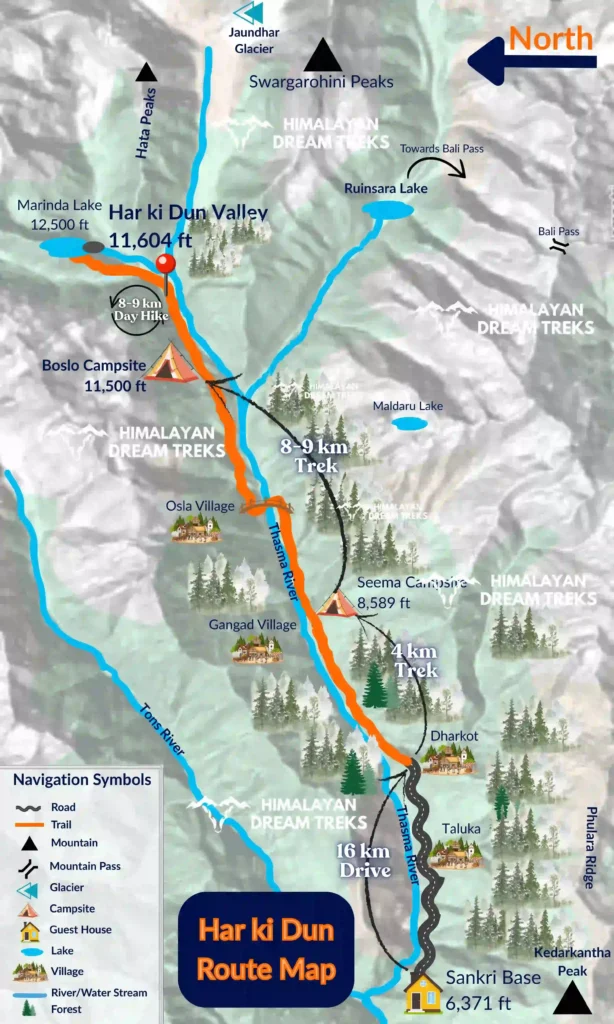
The Har Ki Dun trek is a path to heaven that takes you through the pristine valleys of the Garhwal Himalayas. With its breathtaking landscapes, this ancient route has been traversed for centuries by the indigenous people of the Garhwal region, offering a glimpse into their rich traditions.
Trading Tales Along the Age-Old Path
Har Ki Dun has served as an ancient trade route between the Yamuna and Tons rivers for centuries. Traders and travelers used this route to exchange goods, and it played a vital role in the economic and cultural exchange between the Himalayan regions and the plains of India.
Yudhishthira’s Path to Heaven
According to Hindu mythology, from the epic Mahabharata, the Pandavas took this very route on their journey to heaven. Thus, the trek holds religious significance for Hindus and is often associated with legendary heroes.
In fact, the Swargarohini is one of the focussed attractions of the Har ki Dun trek. Also, Swargarohini peaks are believed to be the only way to heaven on earth. Once you visit this peak, you’ll feel that it’s a simple method to detox your spirit and soul.
Influence of Thang Ta Culture
The indigenous people of the region, primarily the Bhotiya and Jaunsari tribes, have their unique culture and traditions. The Thang Ta, a martial art form, is widely practiced here and has been passed down through generations. Trekkers can also get the chance to witness or even participate in cultural events showcasing these traditions.
The Har Ki Dun hike is well-known for its breathtaking natural beauty and abundant biodiversity.
Rhododendrons- Rhododendrons are also called “Buraans” frequently. The trials often feature these colorful red and pink flowers, especially in the spring. They give the luxuriantly green surroundings a splash of color. Even the juice from this flower is well-liked in Uttarakhand and is frequently seen at every village gathering.
Pine and Deodar Trees- The hike passes through lush stands of pine and deodar trees. These enormous conifers create a shaded and tranquil environment.
Himalayan Monal- This bright pheasant is frequently noticed in the area due to its iridescent plumage. It serves as Uttarakhand’s official bird.
Numerous Bird Species- A wide variety of bird species may be found in Har Ki Dun, including the Himalayan griffon, golden eagles, and several finches and thrushes.
Within the Garhwal region of the Indian Himalayas, Har Ki Dun is a fantastic hiking location. This hike offers outdoor enthusiasts access to numerous surrounding sites and exhilarating treks including Ruinsara Tal Trek, Bali Pass Trek, Rupin Pass Trek and more.
Among the highlights is the chance to behold the awe-inspiring Swargarohini peaks, which hold significance as the supposed pathway to heaven in Hindu mythology. An excellent location for birdwatching and wildlife observation, Har Ki Dun’s lush meadows and coniferous forests offer chances to spot Himalayan animals like the snow leopard and the charming musk deer.
Additionally, while you travel the trail, you’ll pass through the charming villages of Osla and Taluka, which provide a unique glimpse into the rich culture and traditions of the nearby Garhwali people and enable trekkers to engage in genuine cultural interactions.
Gallery
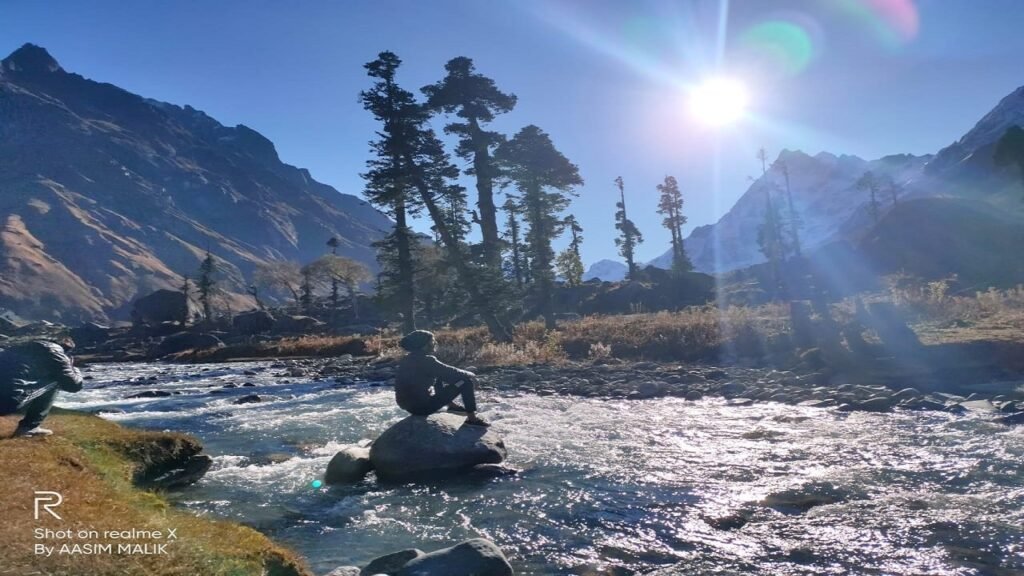
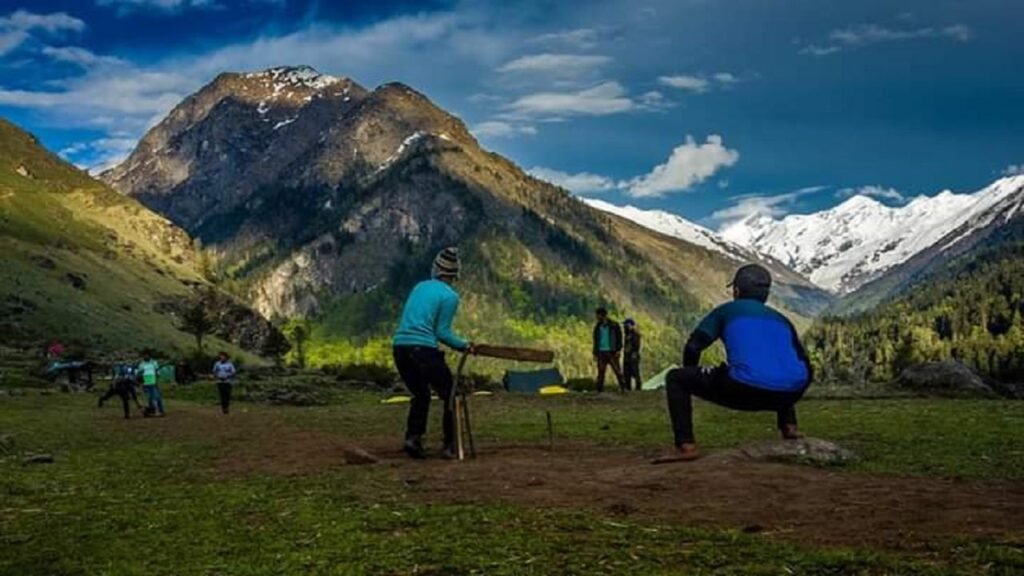


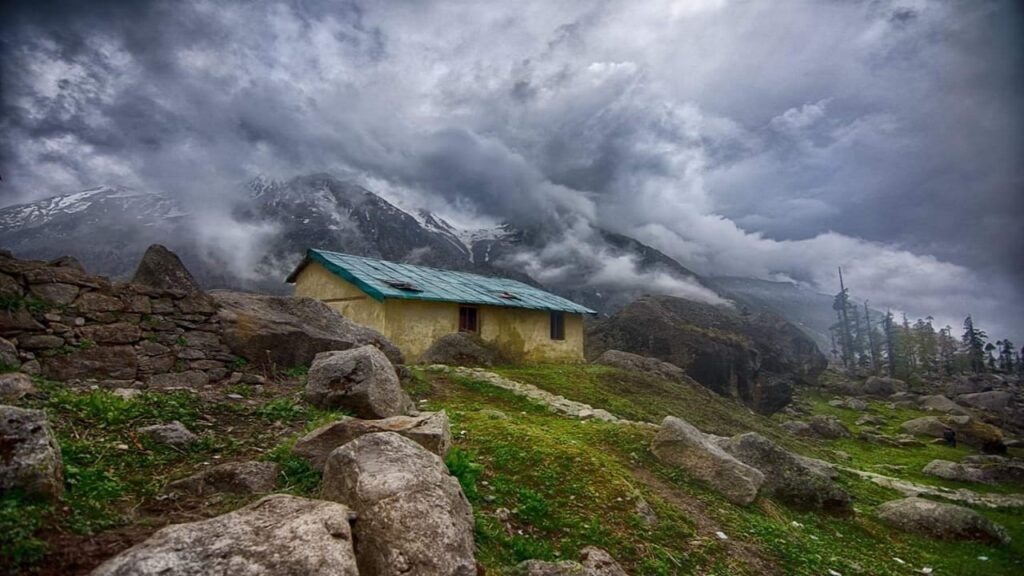
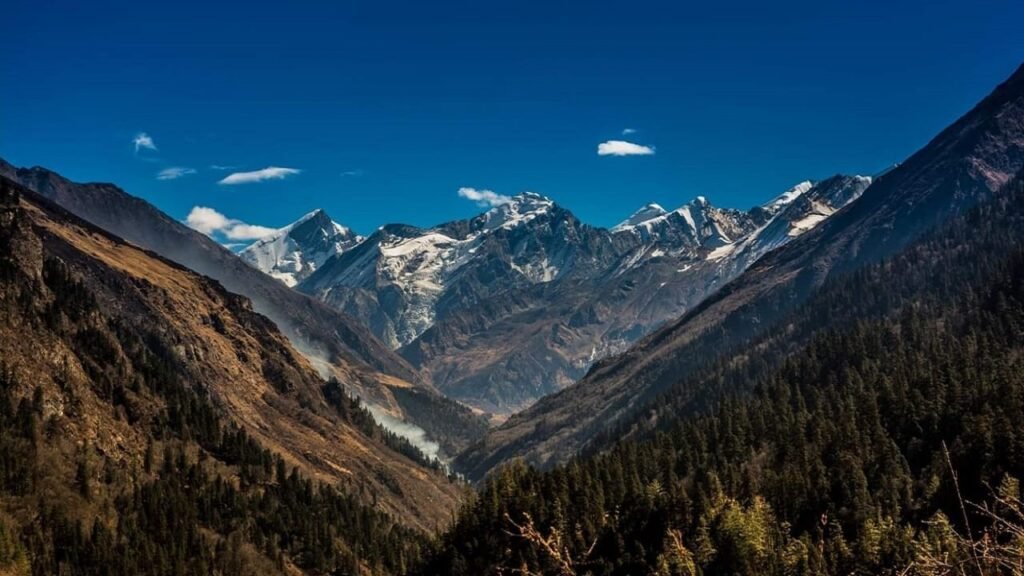
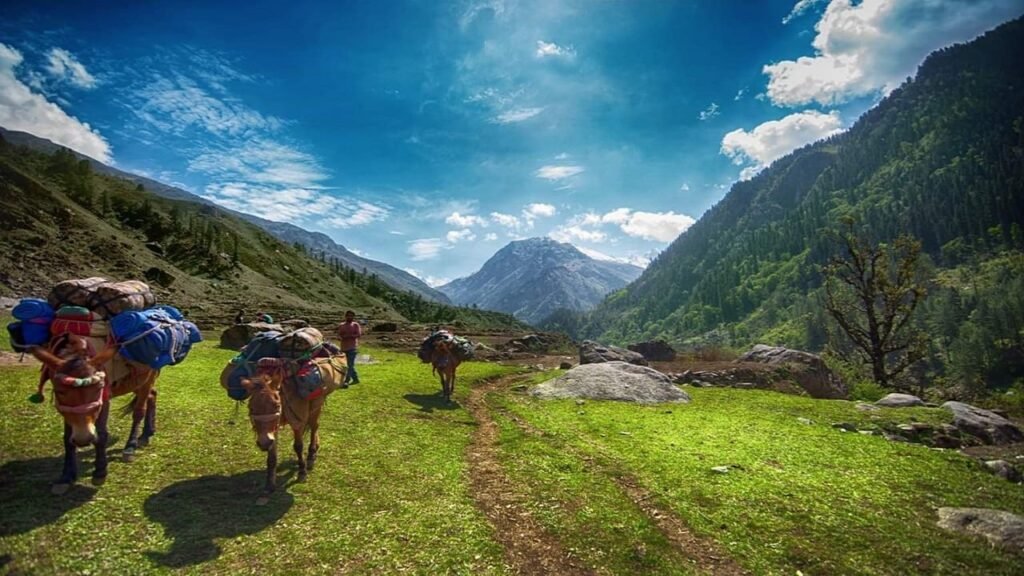
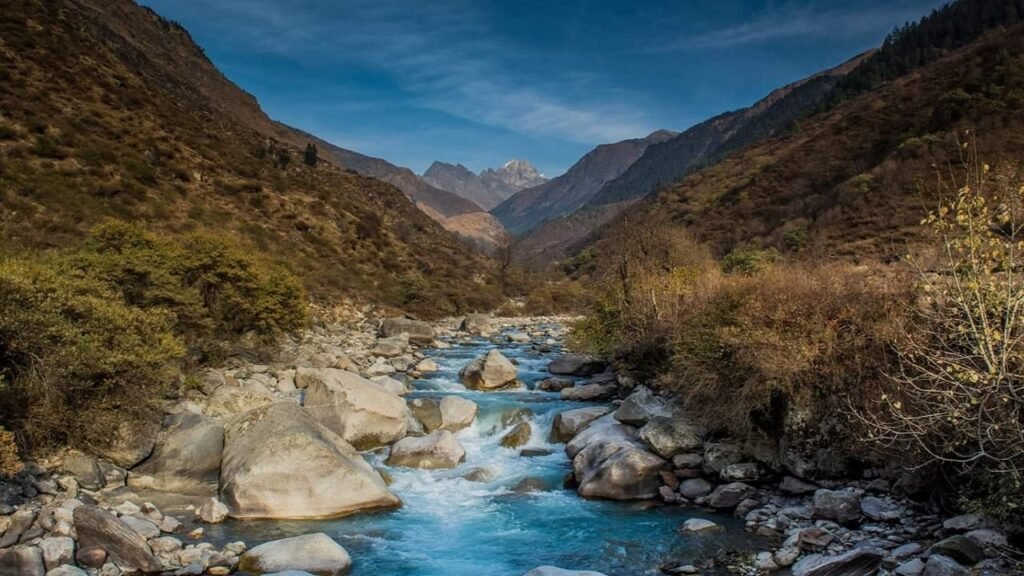
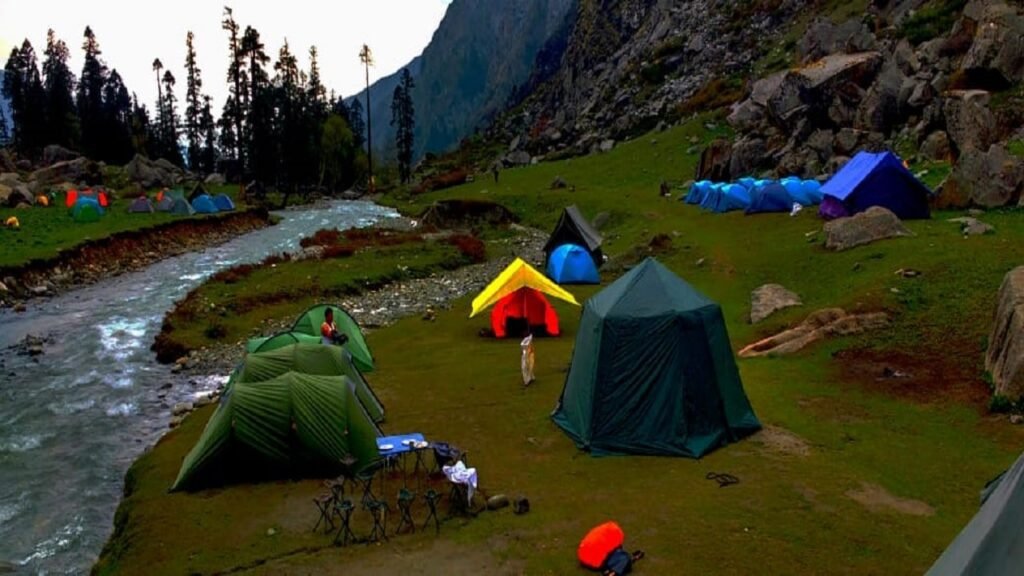

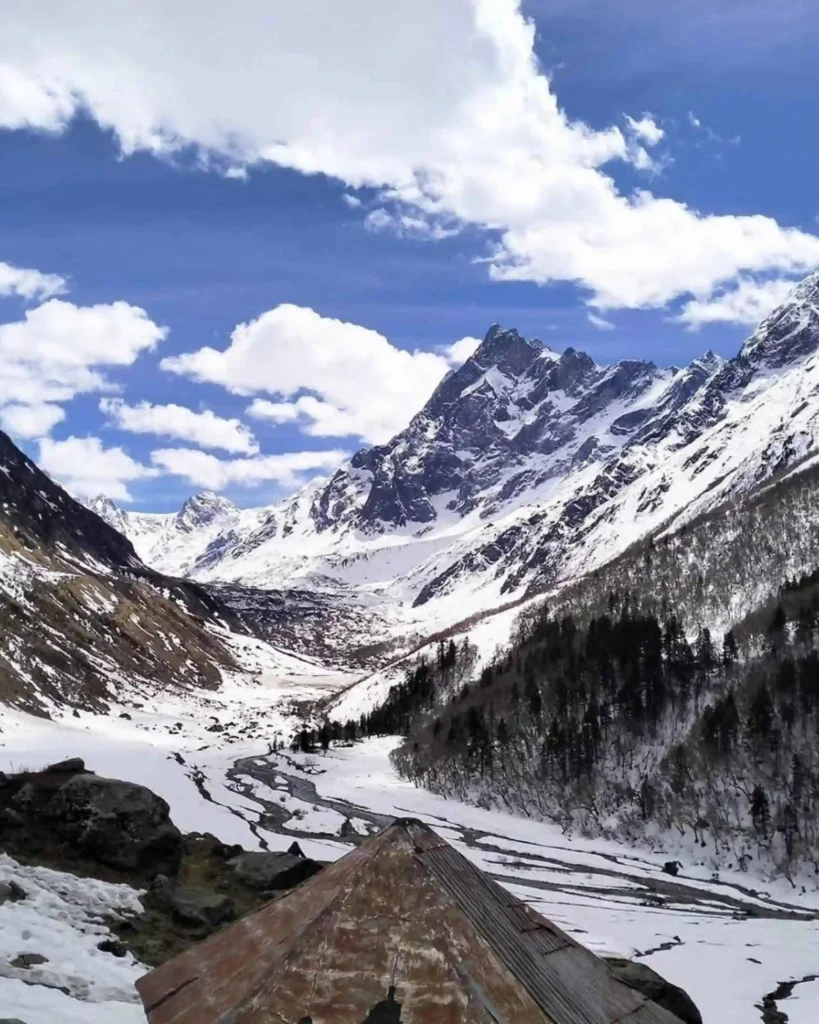

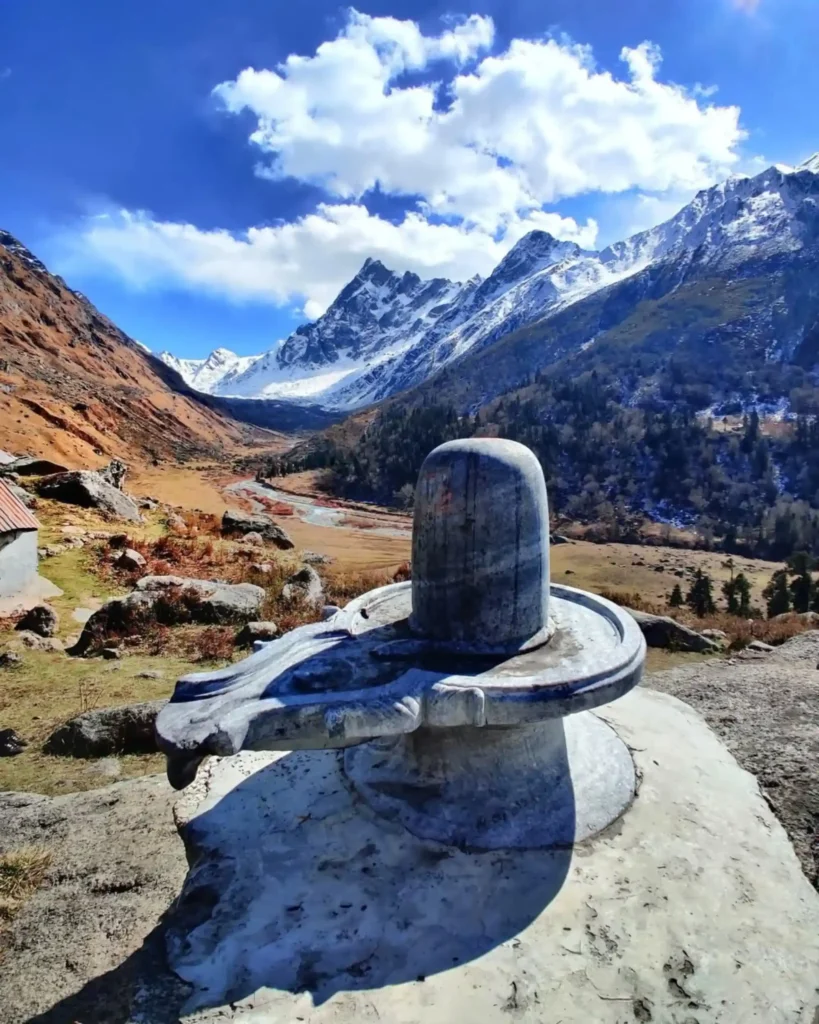
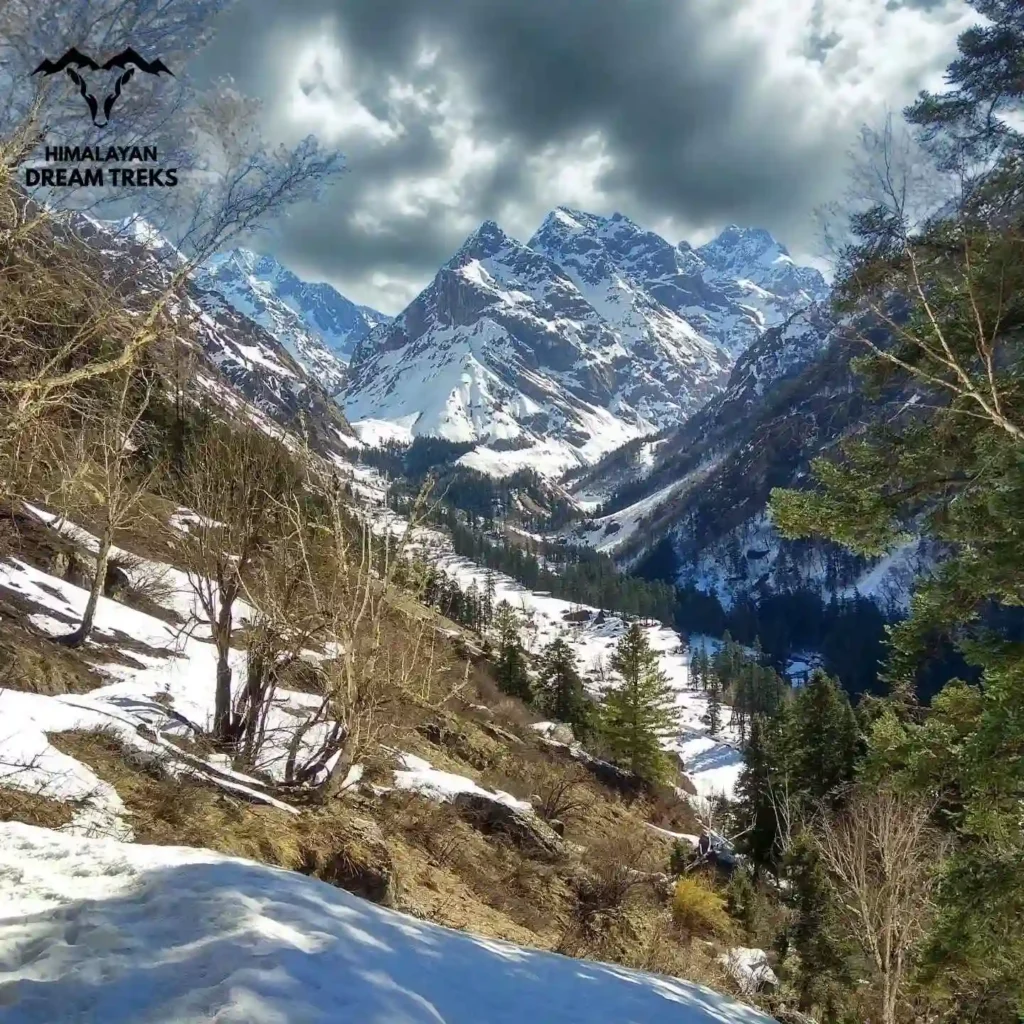
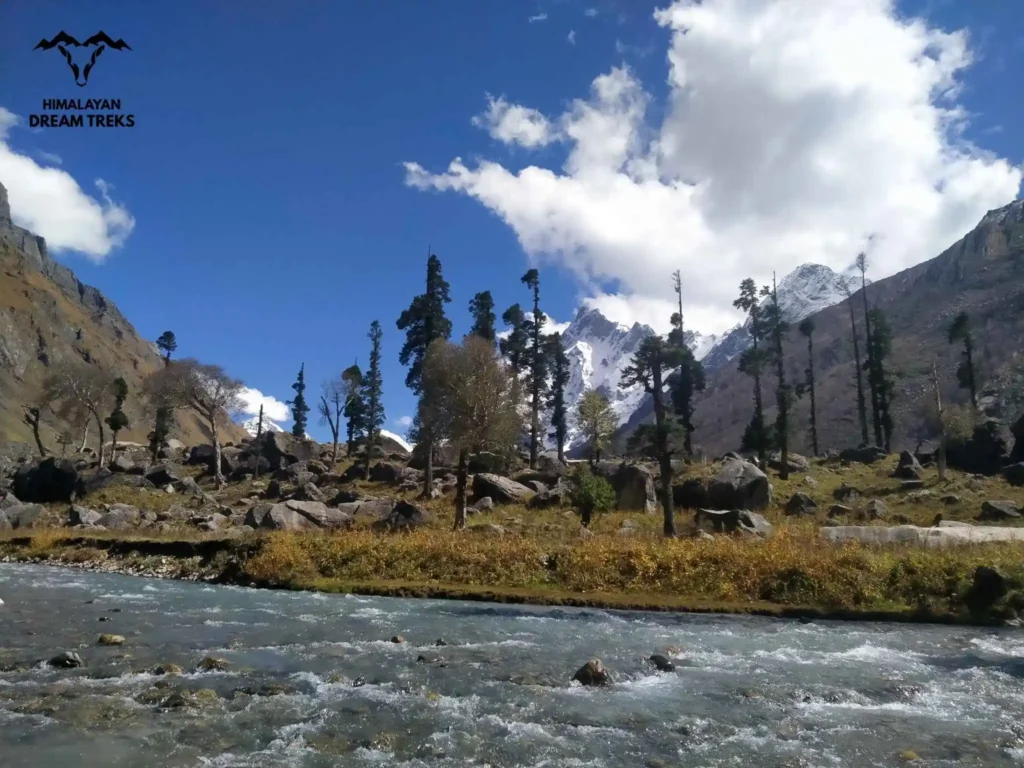
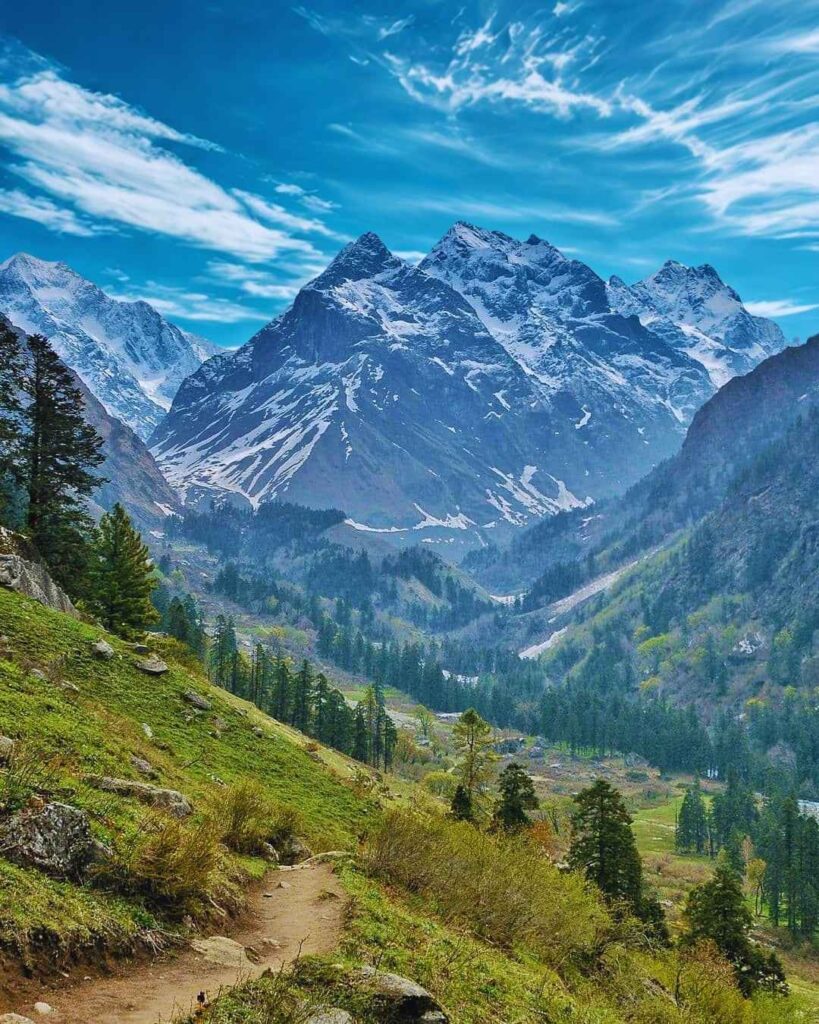
FAQs
The Tons River originates from the Har Ki Dun in Garhwal. This river is the largest tributary to the River Yamuna. In addition, the Supin River flows along a trekking route from Taluka to Seema and Ruinsara River from Ruinsara Lake.
The nearest ATM to Sankri is typically located in Purola, a town relatively close to Sankri. It is a common stop for trekkers and travelers heading to Sankri, and you can usually find ATM facilities there to withdraw cash for your journey. However, it’s also a good idea to carry some money with you, as ATM availability in remote areas can be limited and subject to availability.
Har Ki Dun sees snowfall during winters, generally from late November to early March, with December and January being the coldest. So, if you’re seeking snow-covered trials, plan your trek during this period, but be prepared for freezing weather and challenging trekking conditions due to snow.
The Bandarpunch, Black Peak, Kalanag, Swargarohini, Jaundhar Glacier, and Hata Peak can all be seen from the Har Ki Dun trek in Uttarakhand, India.
In the Har Ki Dun Trek package, stays in a guesthouse and tents are included. On the first day of arrival, you will be accommodated in a guesthouse offering a comfortable and cozy stay. The rooms have attached washrooms, and electric geysers are provided for trekkers.
During the trek, neat and clean alpine 4-person tents will be provided on a triple-sharing basis. These tents are spacious and comfortable for a restful stay.
Additionally, Har Ki Dun trek is organized in groups, and the package from Dehradun to Dehradun typically covers transfers, accommodation, meals, guides, permits, and all the necessary arrangements.
Yes, we provide. If you’re looking for a private holiday package for the Har ki Dun Trek, we provide our guests with an option for tailor-made adventure holidays in the Uttarakhand Himalayas. Whether you’re a solo traveler, a group of friends, or a family, you can opt for your personalized trekking program. This option will allow you to enhance the quality of essential services of facilities such as accommodation, transportation, meals, guides or add-ons for any other requirements. Take a look at the features that make a customized tour package different from a ready-made plan for the trek.
- Itinerary: Design your itinerary instead of following a pre-designed one. This will allow you to experience more sightseeing options and activities during the trek. Our travel experts can help you with this, or you can provide an itinerary that best suits your requirements.
- Transportation: We provide you with a well-maintained, neat & clean vehicle of your choice (Swift/Ertiga/Innova/Tempo Traveler) to travel from Dehradun to Sankri Base and back. This transport service will be dedicated only to your group.
- Accommodation: We provide comfortable & cozy homestay accommodation in Sankri, and during the trek, you will be provided with the best camp stay (A-Shape/North Face/Mountain Hardware).
- Meals: For an unparalleled trekking experience, the meal plan is a core factor of service inclusions. You can provide your own meal routine and list of items to be included/excluded, ensuring they best suit your requirements.
- Equipment: Like the standard package, there will be neat & clean equipment, but in dynamic packaging, you can add extras such as air mattresses, air pillows, inner liners, upgraded sleeping bags, trekking poles, hiking boots, extra oxygen cylinders, etc.
- Private Group: Switching from a group departure to a private one is mostly preferred by families and trekkers who want a personalized experience of trekking in the mountains. No other participants will be added to your group. We offer you the option to have a dedicated group exclusively just for you, with enhanced services or the same services as a standard package.
At Himalayan Dream Treks, we serve wholesome, nutritious Indian vegetarian food during the trek. Here’s what you can expect:
- Breakfast: Start your day with lemon tea in your tent, followed by hot options like upma, aloo paratha, besan chilla, poha, daliya, corn flakes, or Maggi, along with tea or coffee.
- Lunch: A simple, healthy, and balanced meal to keep you energized.
- Evening Refreshments: Tea with light snacks around 4:00 PM.
- Dinner: A hot, delicious meal, including Indian bread, vegetables, lentils, rice, and dessert.
Our food menu is thoughtfully designed to meet trekkers’ nutritional needs, ensuring a perfect balance of calories, protein, and essential vitamins. Every meal is prepared with care by our skilled cooks, making your trekking experience both satisfying and delightful. The quality of our food speaks for itself, as reflected in the glowing feedback from our past guests.
This valley remains closed for exploration during winter due to the heavy snowfall and is not accessible at that time. The best seasons to visit are from April to June in summer and from September to November in autumn. However, in past years, the valley has occasionally experienced significant snowfall in April and November, though this entirely depends on the weather conditions. If you’re looking for guaranteed snowfall, it’s best to explore other winter treks in Uttarakhand.
No, this trek cannot be done completely alone. As per forest department regulations, trekking in this region requires a local guide and valid permits, which can only be obtained through a registered trekking agency like us (Himalayan Dream Treks). Independent trekking is not allowed for safety and environmental reasons. So even if you prefer trekking solo, you’ll need to go through a local agency to arrange the necessary permits and guide support.
Similar Treks
10,500
/ Per Person
Available Dates
| Group Dates | Status |
| 8 March 2025 | Booking Open |
| 15 March 2025 | Booking Open |
| 22 March 2025 | Booking Open |
| 29 March 2025 | Booking Open |
Talk with our trekking experts: +91 80896 93825 / +91 94565 46051
| Group Dates | Status |
| 5 April 2025 | Booking Open |
| 12 April 2025 | Booking Open |
| 19 April 2025 | Booking Open |
| 26 April 2025 | Booking Open |
Talk with our trekking experts: +91 80896 93825 / +91 94565 46051
| Group Dates | Status |
| 3 May 2025 | Booking Open |
| 9 May 2025 | Booking Open |
| 10 May 2025 | Booking Open |
| 17 May 2025 | Booking Open |
| 24 May 2025 | Booking Open |
| 31 May 2025 | Booking Open |
Talk with our trekking experts: +91 80896 93825 / +91 94565 46051
| Group Dates | Status |
| 7 June 2025 | Booking Open |
| 14 June 2025 | Booking Open |
| 21 June 2025 | Booking Open |
| 28 June 2025 | Booking Open |
Talk with our trekking experts: +91 80896 93825 / +91 94565 46051

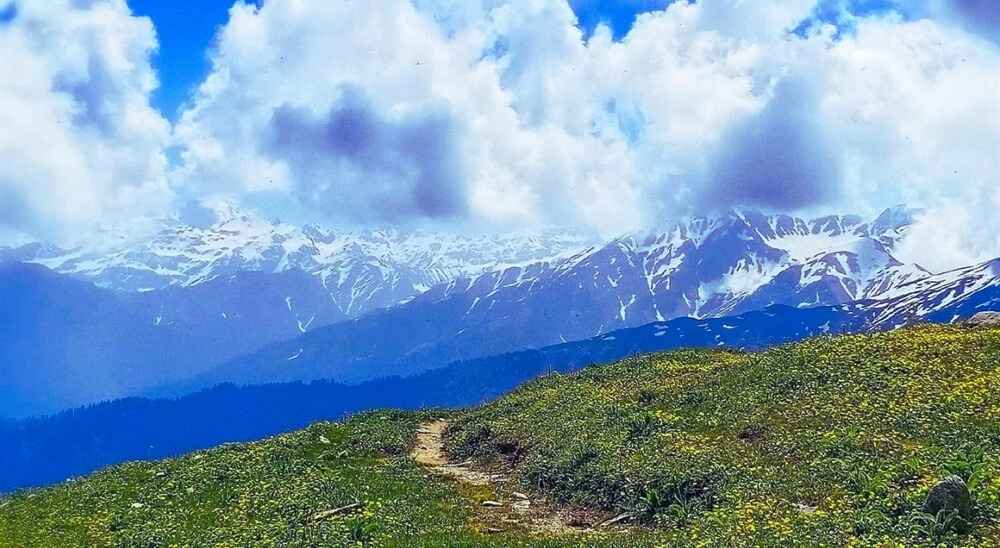
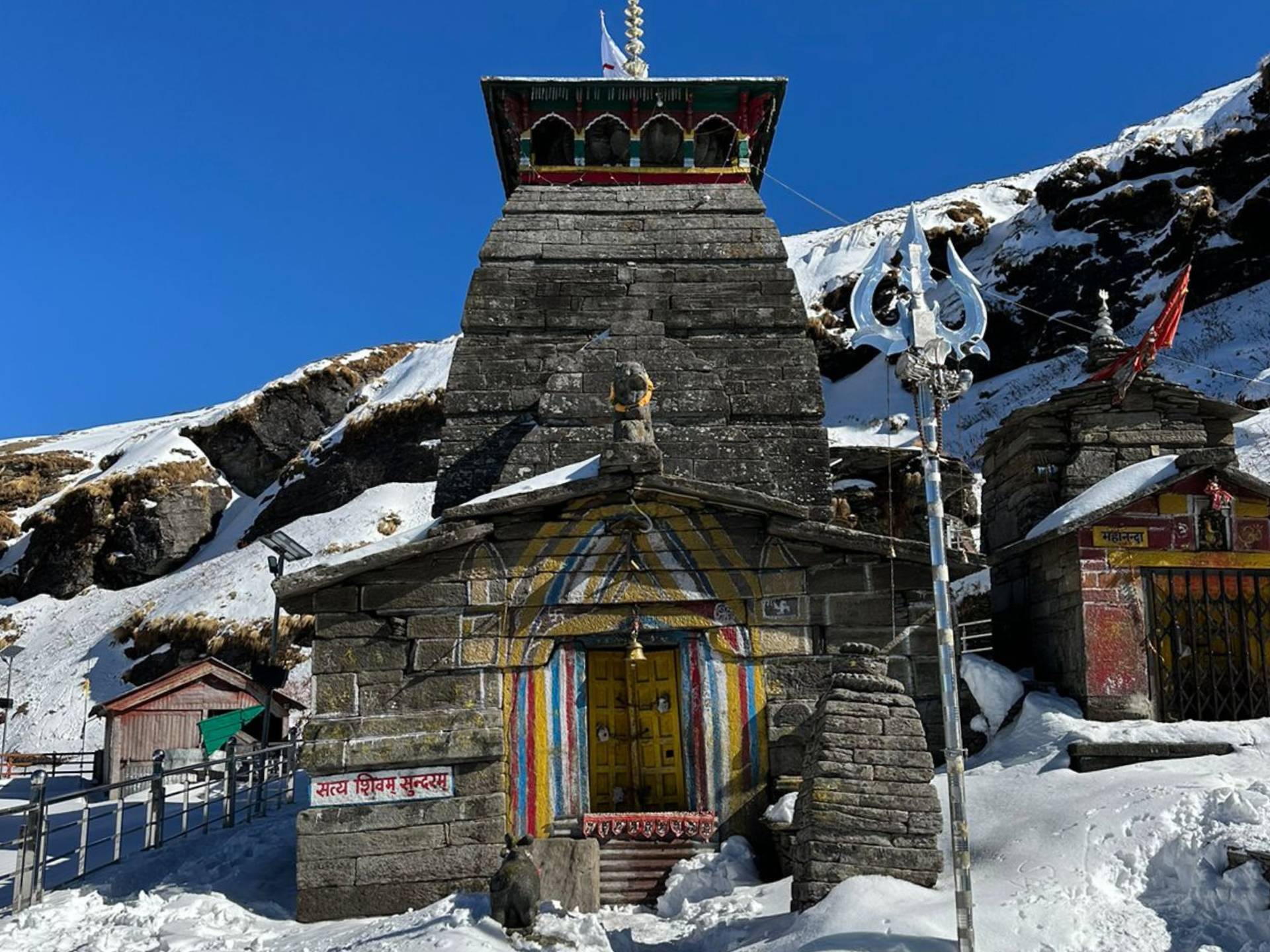

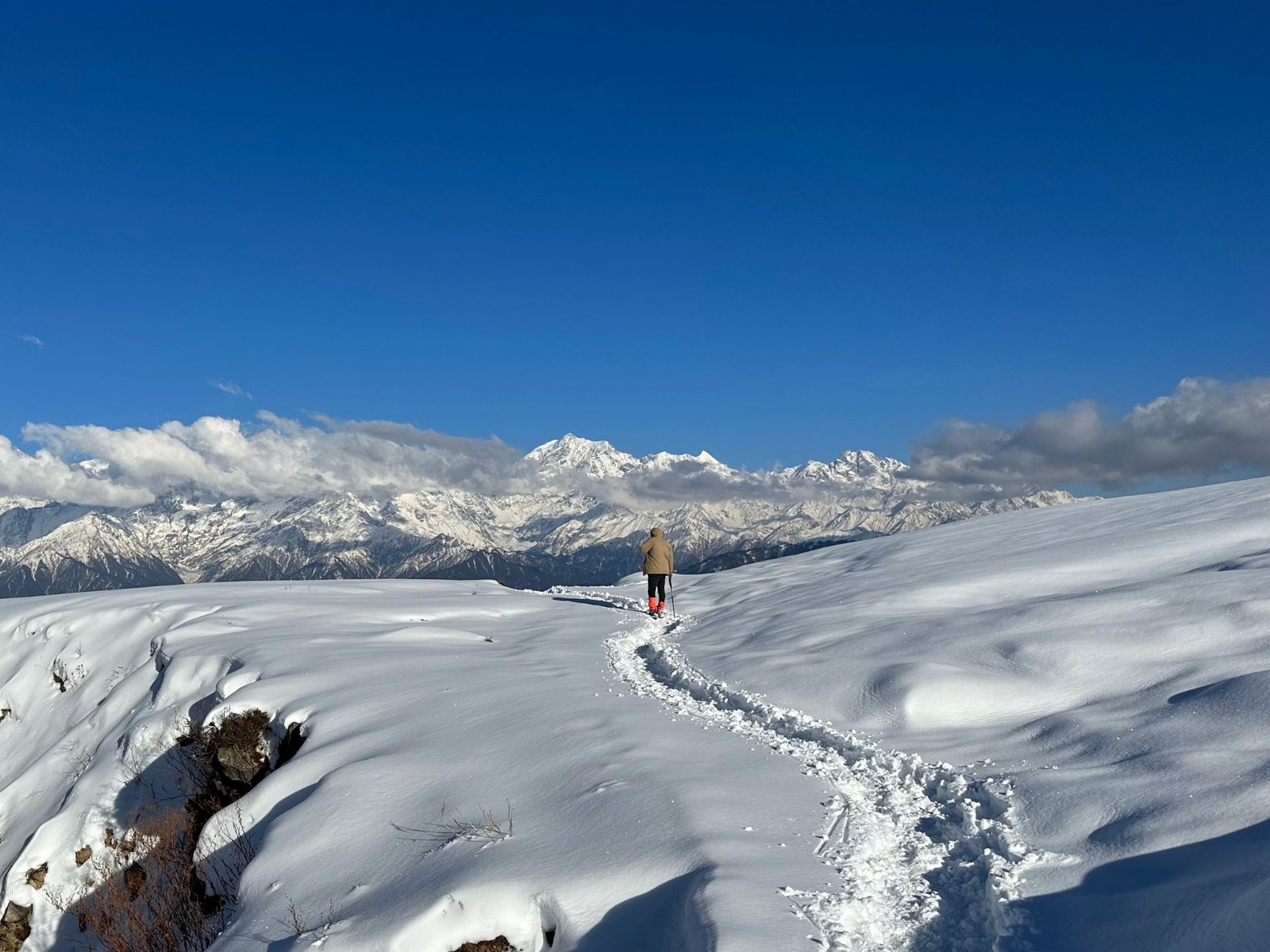



Leave a Comment